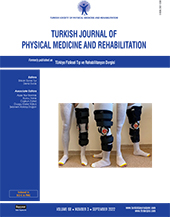Is virtual reality training superior to conventional treatment in improving lower extremity motor function in chronic hemiplegic patients?
2 Department of Physical Therapy and Rehabilitation, Kütahya Health Sciences University, Faculty of Health Sciences, Kütahya, Türkiye DOI : 10.5606/tftrd.2022.9081 Objectives: This study aims to examine the effect of virtual reality (VR) training, frequently included in rehabilitation programs, on lower extremity functional status, mobility, balance, and walking speed in chronic stroke patients.
Patients and methods: This randomized, controlled study was conducted with 60 chronic stroke patients (26 males, 34 females; mean age: 64.0 years; range, 33 to 80 years) who presented to the physical therapy and rehabilitation outpatient clinic of the Kütahya Health Sciences University Evliya Çelebi Training and Research Hospital between February 2019 and February 2020. The participants were randomized to the VR group and the control group by simple randomization with 1:1 allocation. The VR group received 30 min of VR training and 30 min of conventional physiotherapy, while the control group received 60 min of conventional physiotherapy. The patients were evaluated before and after treatment using the Fugl-Meyer Assessment-Lower Extremity (FMA-LE), Rivermead Mobility Index (RMI), 10-m walk test (10MWT), and Berg Balance Scale (BBS).
Results: The FMA-LE, RMI, 10MWT, and BBS scores significantly improved in both groups after treatment (p<0.001). The post-treatment change in the FMA-LE score was significantly higher in the VR group than in the control group (Z=-3.560, p<0.001). Similarly, the change in the BBS score was significantly higher in the VR group (Z=-3.769, p<0.001). Post-treatment changes in the RMI and 10MWT were not significant (p>0.05).
Conclusion: Virtual reality training combined with conventional physiotherapy was found to be superior to conventional physiotherapy alone in improving lower extremity functional status in chronic stroke patients; therefore, adding a VR component to rehabilitation programs will have a favorable impact on treatment outcomes.
Keywords : Chronic stroke, lower extremity, motor function, rehabilitation, virtual reality

















